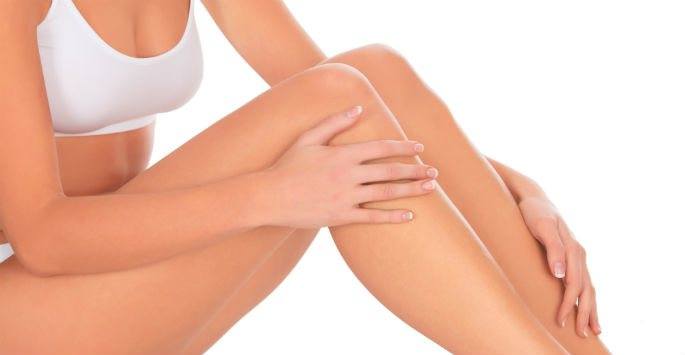Appearance and Location
Varicose veins are large and twisted veins that most commonly develop in the thighs and legs. While sometimes as small as 2.5 mm, they can easily reach 10 mm or more in diameter. Because of their size, varicose veins tend to make the skin bulge outward, appearing as bumps or ropey protrusions under the skin.
Spider veins are tiny blue or red veins that appear at the skin surface. While most commonly seen on the legs (sometimes near varicose veins), they can also appear on the face or chest.
Since they are much smaller than varicose veins, typically less than 1 mm in diameter, they are usually flush with the skin. While they can also appear in isolation, spider veins get their name from the fact that they occasionally appear in a group that resembles a spider’s web.
While sometimes seen separately, it is common to see both varicose and spider veins in the same patient.
What causes varicose veins?
Unlike arteries, which have the easier task of carrying blood from the top of the leg to the foot, veins have a much more difficult job – they must carry the blood against gravity, up the leg and back towards the heart.
Veins have one-way valves which help them to direct the blood up the leg. When functioning properly, these valves prevent the backwards passage of blood down the leg. Sometimes these valves stop working. When the valves fail, blood tends to pool in the veins, which causes a buildup of pressure.
As pressure builds up in the veins, the vein walls weaken. The veins become engorged, and swollen. Over time the veins become increasingly distended and twisted, eventually becoming visible varicose veins.
What are the signs and symptoms of varicose veins?
For some patients, they may be little more than a cosmetic concern. However, varicose veins can be accompanied by uncomfortable symptoms.
Signs and symptoms of varicose veins include:
- Enlarged, twisted veins that bulge out from the skin
- Aching, cramping or throbbing pain in the legs
- Itchy skin around the affected veins
- Pain after sitting or standing for long periods
- Leg swelling, fatigue, heaviness, or restlessness
- Thickening, hardening or discoloration of the skin
- The appearance of skin ulcers, usually around the ankle
In addition, varicose veins can be associated with other venous problems, such as formation of blood clots in the deep veins (i.e., deep venous thrombosis or DVT).
What causes spider veins?
Spider veins sometimes appear due to increased pressure in larger veins beneath the skin surface. This increased pressure may be due to leaky valves in the larger veins, but that is not always the case.
It is often difficult to determine exactly what causes spider veins in a given, although certain risk factors for spider veins do exist (see below).
What are the symptoms of spider veins?
Most often spider veins are asymptomatic, but they can be a considerable cosmetic concern. Patients often report being very self-conscious about exposing their spider veins, which impacts their confidence in wearing certain clothes or engaging in otherwise enjoyable activities.
Sometimes spider veins can cause symptoms. When this occurs, patients typically report itching or burning pain. In some women, these symptoms increase right before their menstrual period.
Rarely spider veins can cause more serious problems, such as rupturing and bleeding.
Who is most likely to develop varicose veins or spider veins?
Varicose veins and spider veins have the same factors. They may include the following:
- Heredity – these conditions tend to run in families.
- Occupation – jobs that require lots of standing or sitting increase the risk of getting varicose and spider veins.
- Sex — although the can certainly occur in men, women are more susceptible to these conditions.
- Age — the older you get, the more likely they are to appear.
- Multiple pregnancies
- Obesity
- A history of blood clots
- Trauma
- Prior vein treatment
Schedule Your Appointment
Contact Beach Cities Vein & Laser Center today to schedule your consultation.

